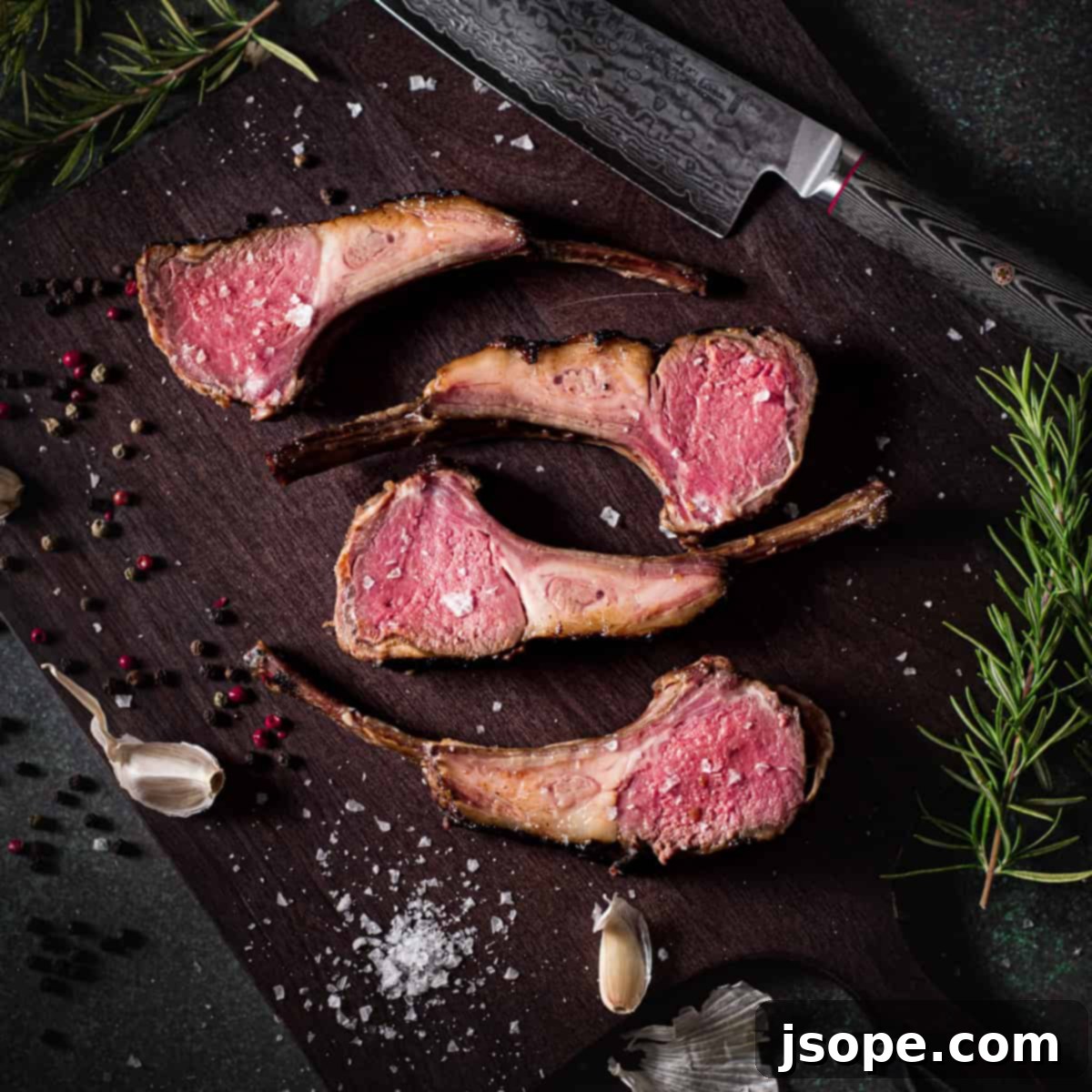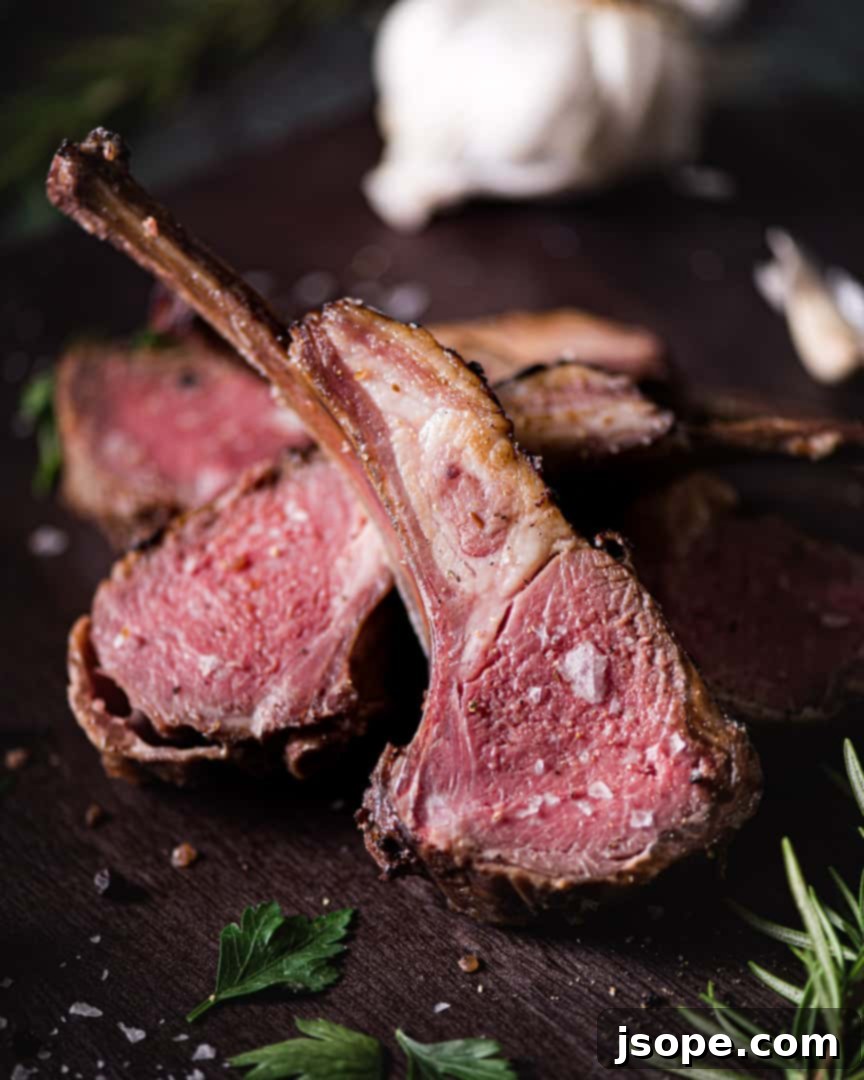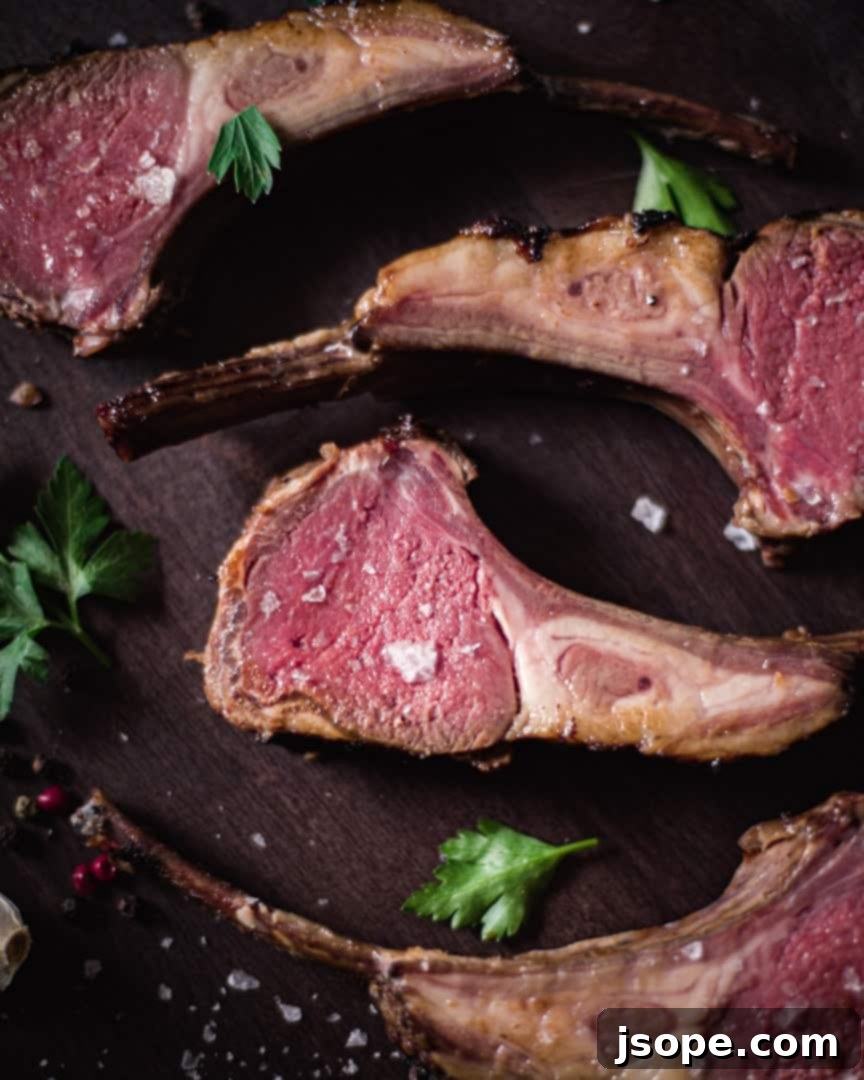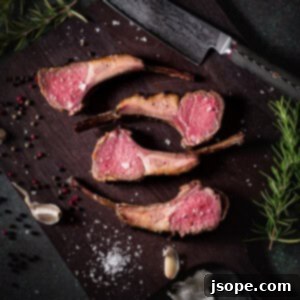Unlock a culinary secret that transforms ordinary meals into extraordinary experiences: sous vide cooking. This innovative method is a game-changer for preparing a wide array of dishes, but it truly shines with thick cuts of meat like lamb, which often prove challenging to cook evenly using traditional methods. Imagine a succulent, perfectly cooked rack of lamb, infused with a vibrant blend of spicy habanero, sweet honey, and savory soy. That’s precisely what our Habanero Honey Soy Sous Vide Rack of Lamb delivers – a dish that epitomizes flavor, tenderness, and precision. Prepare to discover how sous vide elevates this classic cut, ensuring every bite is consistently delicious and utterly unforgettable. This recipe is not just about cooking lamb; it’s about mastering a technique that guarantees perfection, making it an ideal showcase for both the rich flavor of lamb and the unparalleled benefits of sous vide.

The journey to culinary perfection for this Habanero Honey Soy Rack of Lamb begins and ends with sous vide. This method guarantees that your lamb reaches an exquisite level of doneness, tender beyond belief, and imbued with an incredible spicy-sweet marinade. Each bite promises a harmonious explosion of flavors that will undoubtedly make this recipe a staple in your kitchen. The blend of fiery habanero, luscious honey, and umami-rich soy sauce creates a glaze that caramelizes beautifully during the final sear, adding another layer of irresistible taste and texture. Get ready to fall deeply in love with this unforgettable flavor combination and the flawless results that sous vide consistently provides.
What is Sous Vide? The Secret to Perfectly Cooked Meals
Sous vide, meaning “under vacuum” in French, is a precise cooking technique that involves immersing vacuum-sealed food in a temperature-controlled water bath. Unlike conventional cooking methods where heat fluctuates, sous vide uses a specialized device called a water circulator to maintain an exact, consistent temperature throughout the cooking process. This ingenious approach ensures that your food cooks uniformly from edge to edge, reaching the exact desired doneness without any risk of overcooking the exterior while the interior remains underdone.
The benefits of sous vide extend far beyond just even cooking. This method locks in moisture and natural flavors, resulting in incredibly tender and succulent meats, fish, and vegetables. For cuts like a rack of lamb, which can be tricky to cook perfectly on a grill or in an oven, sous vide eliminates the guesswork. The gentle, consistent heat allows the muscle fibers to relax and tenderize over several hours, breaking down connective tissues without drying out the meat. This process retains all the delicious juices and marinades, intensifying the flavor profile of dishes like our Habanero Honey Soy Rack of Lamb. Whether you’re aiming for a perfectly medium-rare steak, flaky salmon, or vibrantly crisp vegetables, sous vide consistently delivers phenomenal results, making it a favorite among professional chefs and home cooks alike. It’s a method that truly allows the natural qualities of your ingredients to shine.
Essential Equipment for Sous Vide Cooking
Embarking on your sous vide journey is more accessible than you might think, and the initial investment in equipment is surprisingly modest, especially when considering the consistently high-quality results you’ll achieve. While some specialized tools are required, these are generally affordable and durable, promising years of gourmet cooking right in your own kitchen. Understanding what each piece of equipment does and how to choose the right one for your needs will set you up for sous vide success.
The Water Circulator: The Heart of Your Sous Vide Setup
The most critical piece of equipment for sous vide cooking is the immersion circulator, often simply referred to as a “sous vide machine.” This device clips onto the side of any pot or container, heating the water and circulating it to maintain a precise temperature. Our trusted circulator, which you can find HERE, has served us faithfully for about four years, performing as flawlessly as it did on day one. When selecting a circulator, consider features like power (for faster heating), ease of use (digital display, app connectivity), and reliability. There are many excellent brands on the market, offering various price points and functionalities, so you can easily find one that fits your budget and cooking style. A good circulator is a long-term investment that pays dividends in perfectly cooked meals.
The Water Vessel: Your Sous Vide Bath
Next, you’ll need a container to hold the water bath. The good news is that you likely already own a suitable vessel! A large stockpot works perfectly for most applications. For a while, we relied on a standard stockpot, which was entirely adequate. However, for those who plan to cook larger items or for longer durations, investing in a dedicated sous vide container can be beneficial. We eventually upgraded to THIS specialized container with a cover. The cover helps minimize water evaporation during extended cooking times and provides better insulation, making your circulator more energy-efficient. Look for containers made from food-safe plastics or heat-resistant materials. The size should accommodate the food you plan to cook and allow for proper water circulation around the bags.
Vacuum Sealing: Protecting Your Food
While a vacuum sealer isn’t strictly mandatory to start, it’s a highly recommended investment if you intend to make sous vide a regular part of your cooking repertoire. Vacuum sealing efficiently removes air from the bag, ensuring maximum contact between the food and the water, which is crucial for even heat transfer. This also prevents bags from floating and ensures the best cooking results. We particularly favor THIS convenient handheld vacuum sealer paired with THESE zipper vacuum bags for their ease of use and reliability. You can explore a wide range of options HERE to find what suits your needs. Beyond sous vide, a vacuum sealer is fantastic for food preservation, extending the freshness of ingredients in your freezer.
If you’re just dipping your toes into sous vide and aren’t ready to commit to a vacuum sealer, standard Ziplock-style freezer bags are a perfectly viable alternative. The key is to remove as much air as possible to prevent your food from floating. The most effective method is the water displacement technique: gradually submerge the bag (with its contents and most of the air pushed out) into the water bath, leaving a small corner of the zipper open. The water pressure will naturally force out the remaining air. Once most of the air is expelled, seal the bag completely before fully submerging it. Alternatively, you can use a straw to suck out the air before sealing, though the water displacement method is generally more efficient for larger items.
It’s important to note a potential limitation with Ziplock-style bags, especially when cooking at higher temperatures (above 160°F or 71°C) for extended periods. Some standard bags may not withstand these conditions, potentially compromising the seal or bag integrity. This is a factor to consider when choosing your bags, particularly for recipes requiring long cooks or higher temperatures. For consistent peace of mind, especially with delicate or high-value ingredients, dedicated sous vide bags or a vacuum sealer are often preferred.

Crafting the Perfect Habanero Honey Soy Sous Vide Rack of Lamb
With your sous vide equipment ready, it’s time to bring this sensational Habanero Honey Soy Rack of Lamb to life. Despite its gourmet appeal, the process is incredibly straightforward, thanks to the precision of sous vide. The majority of the work is handled by the water bath, allowing you to achieve restaurant-quality results with minimal effort. Here’s a detailed breakdown of each simple step to ensure your lamb is nothing short of perfection:
- **Prepare the Marinade and Marinate the Lamb:** In a large, sealable bag (a sturdy Ziplock or a container works well for marinating), combine the rack of lamb with all the marinade ingredients: soy sauce, honey, minced garlic, sesame oil, chopped shallots, finely chopped habanero pepper (remember to wear gloves when handling habaneros to protect your hands from the capsaicin oils), and fresh rosemary sprigs. Ensure the lamb is thoroughly coated in the marinade. Seal the bag, pressing out as much air as possible. Place the marinating lamb in the refrigerator for a minimum of 2 hours to allow the flavors to penetrate the meat. For the most intense and delicious results, we highly recommend marinating it overnight (12-24 hours). This extended marination time tenderizes the lamb further and infuses it with the irresistible spicy-sweet-savory notes.
- **Set Up the Sous Vide Water Bath:** When you’re ready to cook, fill your chosen container (stockpot or dedicated sous vide bath) with water. Attach your immersion circulator securely to the side of the container. Set the desired cooking temperature to 134°F (56.7°C). This temperature typically yields a perfect medium-rare doneness for lamb, which is ideal for tenderness and flavor. Allow the water to heat up completely before adding the lamb. While the water heats, you can prepare the lamb for its sous vide bath.
- **Prepare Lamb for Sous Vide:** Carefully remove the rack of lamb from the marinade bag. At this point, you have a couple of options for the leftover marinade: you can discard it, or, if you desire a flavorful sauce, you can reserve it. If reserving, pour the marinade into a small saucepan and refrigerate it. Later, you can reduce it to create a concentrated sauce, optionally incorporating the flavorful juices from the cooked lamb bag for an extra layer of richness. Transfer the marinated rack of lamb to a new, clean vacuum-sealable bag or a freezer-grade Ziplock bag. Ensure the lamb is laid flat. Use your vacuum sealer to remove all air and create a tight seal. If using a Ziplock bag, employ the water displacement method to remove as much air as possible before sealing.
- **Sous Vide Cook the Lamb:** Once the water bath has reached the set temperature of 134°F (56.7°C), carefully submerge the sealed bag containing the lamb into the water. Ensure the bag is fully submerged and that water can circulate freely around it. Cook the rack of lamb for 5-6 hours. While the lamb will reach its internal temperature equilibrium around the 4-hour mark, cooking for closer to 6 hours provides additional time for enzymatic breakdown, resulting in a noticeably more tender and succulent texture for this specific cut. One of the great advantages of sous vide is its flexibility; if your schedule requires it, you can safely extend the cooking time anywhere from 4 to 7 hours without fear of overcooking, as the temperature remains constant.
- **The Final Searing Flourish:** After the sous vide cooking time is complete, carefully remove the lamb from the water bath and take it out of the bag. Pat the entire rack of lamb thoroughly dry with paper towels – this is a critical step for achieving a beautiful, crispy crust. Place the dried lamb in a roasting pan, fat-side up. Turn your oven’s broiler to high. Place the pan with the lamb under the broiler for approximately 3-5 minutes. Keep a very close eye on it, as broilers can vary in intensity and lamb can go from perfectly browned to burnt quickly. Your goal is to achieve a gorgeous caramelized and browned exterior to your desired level of crispness. This high-heat searing creates the Maillard reaction, developing complex, savory flavors and a delightful texture that complements the tender interior.
Once your Habanero Honey Soy Sous Vide Rack of Lamb has achieved its magnificent golden-brown crust, remove it from the oven. Allow it to rest for a few minutes before carving. Then, using a sharp knife, carefully slice the rack into individual chops, cutting between the bones. A sprinkle of finishing salt, such as flaky sea salt, can enhance the flavors and add a pleasant textural contrast. Serve immediately and prepare for an exceptional dining experience!

Savor Every Bite!
We sincerely hope you cherish every moment of preparing and indulging in this exquisite Habanero Honey Soy Sous Vide Rack of Lamb. This recipe truly showcases the power of sous vide to deliver unparalleled tenderness and flavor, creating a dish that is both impressive and incredibly satisfying. If you decide to try this recipe, we would absolutely love to hear about your experience! Please feel free to leave us a comment below to share your thoughts, tips, or modifications. And if you’re active on social media, don’t forget to tag us on Instagram @cooking_with_wine so we can see your beautiful creations!
For more inspiration and to continue exploring the versatile world of sous vide cooking, be sure to check out some of our other fantastic recipes:
- Sous Vide Short Ribs: Discover how sous vide transforms a tough cut into meltingly tender, flavorful ribs.
- Blood Orange & Thyme Glazed Duck Breast: Experience the perfect crisp skin and juicy interior of duck breast, made easy with sous vide.
- Blueberry Thyme Red Wine Reduction: A perfect accompaniment for sous vide duck breast or other savory dishes, adding a gourmet touch.
📖 Recipe: Habanero Honey Soy Sous Vide Rack of Lamb

Habanero Honey Soy Sous Vide Rack of Lamb
Pin Recipe
Ingredients
- 1 rack lamb (about 2-2.5 lbs)
- ½ cup soy sauce
- ½ cup honey
- 3 cloves garlic, minced
- 1 tablespoon sesame oil
- 2 shallots, chopped
- 1 habanero pepper, chopped (use gloves to prevent oils from burning your hands when chopping)
- 3 fresh rosemary sprigs
- salt to taste
Instructions
- Place all marinade ingredients along with the rack of lamb in a large, sealable bag. Do not cut the lamb into individual chops at this stage. Ensure the lamb is well-coated. Marinate in the refrigerator for a minimum of 2 hours, preferably overnight (12-24 hours) for optimal flavor penetration and tenderness.
- Fill your sous vide container with water and attach the circulator. Set the temperature to 134°F (56.7°C). Allow the water to reach the set temperature. Optional: If you wish to make a sauce, reserve the marinade and refrigerate it. You can later reduce it on the stovetop and combine with the juices from the cooked lamb bag.
- Once the water bath is ready, remove the rack of lamb from the marinade bag and pat it dry. Transfer the lamb to a new, clean vacuum-sealable bag (or use the water displacement method with a freezer-grade Ziplock bag to remove as much air as possible). Submerge the sealed bag containing the lamb into the preheated water bath and cook for 5-6 hours. The longer cooking time within this range will yield a more tender result.
- After the sous vide cooking is complete, remove the lamb from the water bath and carefully take it out of the bag. Pat the entire rack of lamb thoroughly dry with paper towels to ensure a good sear. Place the dried lamb, fat-side up, in a roasting pan. Turn your oven to broil (high heat) and place the pan in the oven for 3-5 minutes, or until the exterior is beautifully caramelized and browned to your desired crispness. Watch closely to prevent burning.
- Allow the lamb to rest for a few minutes before cutting it into individual chops between the bones. Sprinkle with finishing salt, if desired, and serve immediately.
